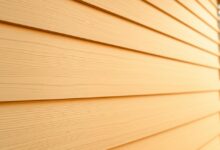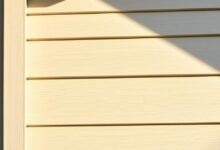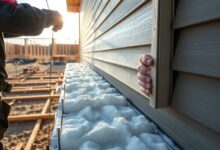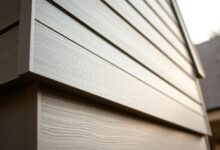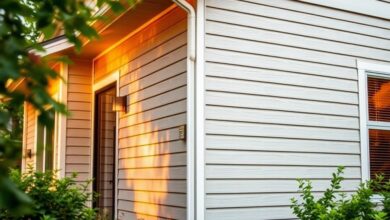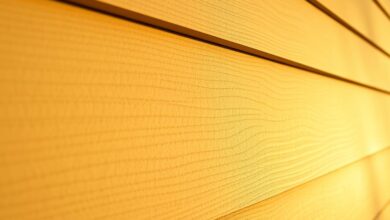How to Maintain Insulated Siding: Tips and Tricks
Homeowners who choose insulated siding aim to keep their homes energy-efficient and looking great. This siding type offers a tough exterior and cuts down on energy bills with its insulation layer.
It’s key to take good care of your siding to keep its benefits. Regular upkeep makes sure your insulated siding works well and lasts longer.
Key Takeaways
- Regular cleaning is essential for maintaining insulated siding.
- Inspect your siding regularly for damage or wear.
- Proper siding care enhances energy efficiency.
- Using the right cleaning solutions is vital.
- Seeking professional help when needed is recommended.
Understanding Insulated Siding and Its Benefits
Insulated siding is more than a cosmetic upgrade. It brings big benefits in energy savings and building strength. This siding has an extra insulation layer. It makes homes more energy-efficient by cutting down heat transfer between inside and outside.
What Makes Insulated Siding Different
Insulated siding stands out from regular siding in its build. It has a siding material like vinyl or metal, plus foam insulation. This mix boosts thermal performance. Homes stay warmer in winter and cooler in summer.
Energy Efficiency and Structural Advantages
The key benefit of insulated siding is better energy use. It cuts down on heat loss in winter and heat gain in summer. This means lower energy bills and less carbon footprint. The insulation also adds strength, making the siding more durable and less likely to get damaged.
Common Types of Insulated Siding Materials
There are many insulated siding options for homeowners. Each has its own benefits and looks.
Vinyl Insulated Siding
Vinyl insulated siding is loved for its affordability and easy upkeep. It comes in many colors and styles, fitting various home designs.
Fiber Cement Insulated Siding
Fiber cement insulated siding is known for its long-lasting durability. It looks like wood siding but doesn’t need the upkeep. It also fights pests and fire well.
Steel and Aluminum Insulated Options
Steel and aluminum insulated siding offer a modern look. These materials are strong and weather-resistant. They’re great for homes in tough weather.
Knowing about different insulated siding types helps homeowners make smart choices. They can pick based on energy savings, durability, and looks. This ensures they get the right siding for their homes.
How to Maintain Insulated Siding: Essential Care Routine
To keep your insulated siding in top shape, regular care is key. This means doing seasonal checks, cleaning safely, and washing right. A consistent routine helps avoid damage, keeps energy costs down, and makes your siding look great.
Seasonal Inspection Checklist
Regular checks help spot problems early. Your seasonal check should look for damage, wear, and make sure everything is secure.
Spring Maintenance Tasks
In spring, clean off winter debris. Look for damage from snow, ice, or wind. Also, check for mold or mildew and fix it fast.
- Clear debris from gutters and downspouts
- Inspect siding for damage or wear
- Treat any mold or mildew
Fall Preparation for Winter
As fall comes, get your siding ready for winter. Clean it well, check for gaps, and make sure everything is tight.
- Clean siding to remove dirt and debris
- Seal any gaps or openings
- Tighten loose siding components
Safe Cleaning Methods and Frequency
Cleaning your siding often keeps it looking and working well. How often you clean depends on where you live and the weather.
Recommended Cleaning Solutions
Use a mild detergent made for siding. Stay away from harsh chemicals or abrasive cleaners that can harm the siding.
Tools and Equipment for Safe Cleaning
Use soft-bristled brushes or sponges for cleaning. Don’t use high-pressure washes unless the maker says it’s okay, as they can harm the siding.
Proper Washing Techniques
How you wash your siding affects its life. Always follow the maker’s cleaning and washing tips.
Pressure Washing Guidelines
If you need to pressure wash, use low pressure and keep the nozzle 12 inches away. Avoid strong jets that can damage the siding.
Hand Washing Delicate Areas
For delicate spots or materials that can get damaged easily, hand washing is best. Use a soft-bristled brush or sponge for a gentle clean.
By sticking to this care routine, you can keep your insulated siding in great condition. It will stay energy-efficient and protect your home well.
Addressing Common Insulated Siding Problems
Even with regular care, insulated siding can face issues that need quick action. Homeowners should know about common problems that can affect their siding’s durability and performance.
Identifying and Repairing Minor Damage
Minor damage to insulated siding can happen due to weather or accidents. It’s important to fix such damage quickly to stop it from getting worse.
Cracks and Small Holes
Cracks and small holes can be fixed with the right sealant. For bigger damage, you might need to replace the panel. Acting fast can stop water from getting in and causing more harm.
Loose or Damaged Panels
Loose panels need to be tightened, and damaged ones might need to be replaced. Making sure panels are securely attached is key to keeping the siding in good shape.
Preventing and Treating Mold or Mildew
Mold and mildew on insulated siding is a big problem, more so in humid or shaded spots. To stop it, clean regularly and make sure air can move around the siding.
Identifying Mold Growth Early
Regular checks can spot mold or mildew early. Look for any discoloration or black spots on the siding. Finding it early is the best way to stop it from spreading.
Safe Removal Solutions
To get rid of mold or mildew, a mix of bleach and water works well. But, always follow safety rules and test it on a small area first to avoid harming the siding.
Handling Moisture-Related Issues
Moisture problems like warping and buckling can harm the siding’s performance. The right installation and upkeep can help avoid these issues.
Warping and Buckling Prevention
To stop warping and buckling, make sure the siding is put in right and has enough air behind it. Regular checks can also spot problems early.
Dealing with Water Infiltration
If water gets in, finding and fixing the leak is key. You might need to repair or replace damaged siding to keep it from getting worse.
By tackling these common issues with insulated siding, homeowners can keep their exterior looking good for many years.
Advanced Maintenance Tips for Longevity
Maintaining your insulated siding is more than just cleaning. It’s about using advanced techniques to keep it looking great for years. By following these tips, homeowners can keep their siding in top shape.
Proper Landscaping Around Siding
The landscaping around your home affects your siding’s longevity. Using the right landscaping techniques can prevent damage and cut down on maintenance.
Safe Distance for Plants and Trees
It’s important to keep plants and trees away from your siding. Plant roots and branches can cause damage if they’re too close. Make sure to keep at least a few feet of space between your siding and any landscaping.
Managing Sprinkler Systems
Controlling your sprinkler system is key to avoiding water damage to your siding. Excessive moisture can lead to mold, mildew, and structural problems. Adjust your sprinkler system to avoid spraying water directly onto your siding.
Protecting Siding During Home Projects
Home renovation projects can sometimes damage your insulated siding. It’s important to take precautions to protect it.
Use protective coverings and barriers to shield your siding from debris, dust, and other damages. This step can save you from expensive repairs later on.
Color Maintenance and Refreshing
Keeping your insulated siding’s color and appearance is not just about looks. It also affects its durability.
Cleaning Discoloration
Regular cleaning can prevent discoloration. For tough stains, use a mild detergent that won’t harm the siding. Avoid using harsh chemicals that can damage the siding’s protective coating.
When and How to Repaint
If your siding is painted, knowing when and how to repaint is key. Look for fading or chipping paint, and repaint with high-quality exterior paint that’s right for your siding material.
When to Call a Professional
While many maintenance tasks can be done yourself, there are times when a professional is needed. If you’re unsure about your siding’s condition or need complex repairs, consulting a professional can prevent further damage and ensure the job is done right.
Conclusion
Keeping insulated siding in good shape is key to its long life. It helps keep your home energy-efficient and looking great. Regular checks, cleaning, and quick fixes are essential to protect your investment.
A well-kept insulated siding boosts your home’s look and keeps it strong. Using smart care methods, like good landscaping and color choices, can make it work even better.
In short, taking care of insulated siding means more than just cleaning. It’s about a detailed plan of regular upkeep and quick fixes. By doing this, homeowners can enjoy their siding for many years. It becomes a valuable part of their home’s exterior.
